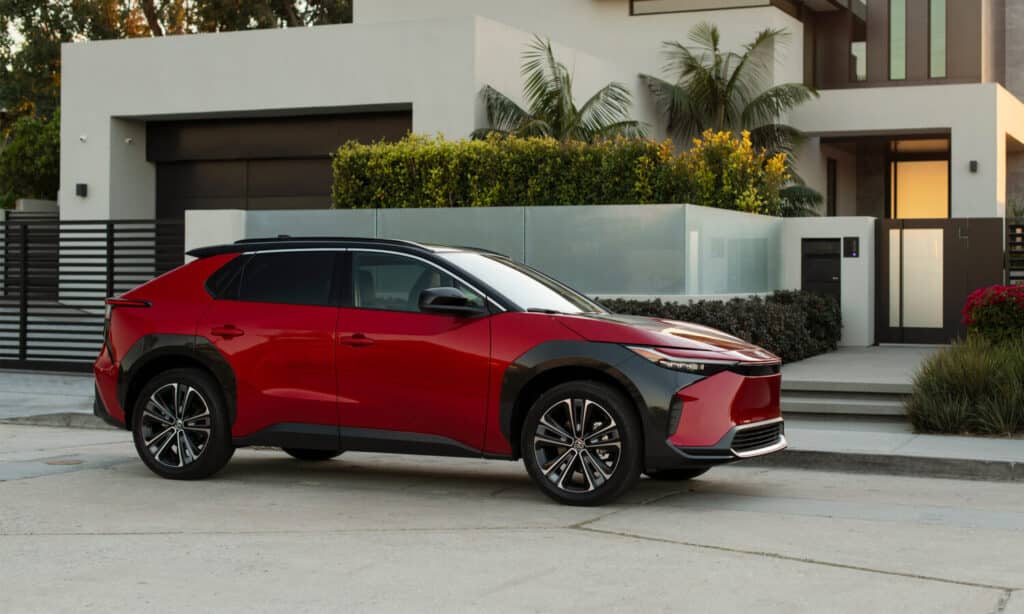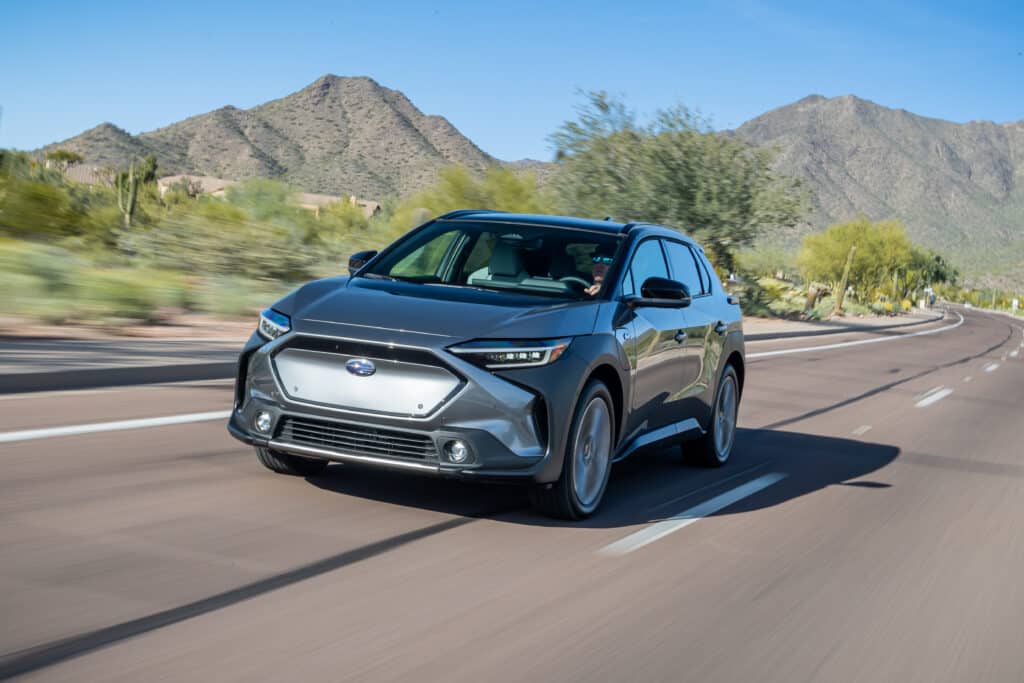Subaru’s Solterra and Toyota’s bZ4X Moving up Fast in US EV Sales
The recent surge in electric vehicle (EV) sales highlights a trend where many drivers seem to have held off on purchasing an EV until their preferred brand introduced a reliable and appealing model. Subaru and Toyota are two brands which have been slow to move to battery electric vehicles (BEVs). However, both OEMs enjoy strong brand loyalty in the US.
When making the change from gas or hybrids to BEVs, the willingness of drivers to wait for their preferred brand also reflects the growing importance of trust and brand loyalty in the EV market. Established automakers with a reputation for quality and reliability have been able to capitalize on this by launching EVs that meet or exceed consumer expectations, thereby driving a substantial portion of the overall market growth.
It’s surprising that Subaru, a brand known for its loyal customer base, didn’t enter the electric vehicle (EV) market until early 2023 with the launch of the Solterra in the U.S. Despite the delayed entry, Subaru’s patient approach appears to be yielding positive results. According to Cox Automotive, Subaru sold 4,200 Solterras in the U.S. during the second quarter of 2024, nearly tripling the model’s sales compared to the same period last year.
Similarly, Toyota’s bZ4X, which debuted in the U.S. at the end of 2022, has also seen impressive growth. The bZ4X recorded 7,600 sales in the second quarter of 2024, marking an almost four-fold increase from the year-earlier period. These numbers suggest that both Subaru and Toyota, despite their relatively late entries into the EV market, are successfully capitalizing on the demand for electric vehicles among their customer bases.
Subaru and Toyota have built reputations as two of the most trusted and reliable brands in the automotive industry, consistently earning high marks in owner satisfaction, reliability, and resale value. Their loyal customer bases are a testament to the strong brand equity they’ve cultivated over the years.
This deep-rooted loyalty has allowed both companies to successfully transition their customer bases to electric vehicles, even with later entries into the market. For many consumers, the decision to switch to an EV is not just about technology but also about sticking with a brand they trust. Subaru and Toyota have leveraged this trust, ensuring that their EV offerings, like the Solterra and the bZ4X, meet the high standards their customers expect.
Toyota’s Innovative, Exciting bZ4X
The 2024 Toyota bZ4X battery electric vehicle comes in two trims: XLE and Limited. It’s starting MSRP is $43,070 as of this writing.
Here’s a summary of key features and specifications that highlight the performance, drivetrain, range, interior, technology, and safety aspects of the Toyota bZ4X:
PERFORMANCE
- Power Output: Up to 214 horsepower
- Torque: 248 lb.-ft. of torque
- These specs provide solid acceleration and responsiveness, contributing to a dynamic driving experience.
DRIVETRAIN
- All-Wheel Drive (AWD): Available with X-MODE
- X-MODE enhances traction and stability in various driving conditions, making it ideal for off-road or challenging weather scenarios.
ESTIMATED RANGE
- Range: Up to 252 miles of estimated all-electric driving range
- This range is competitive, offering enough distance for most daily commutes and longer trips without frequent recharging.
INTERIOR
- Comfort: Heated and ventilated SofTex-trimmed seats (available in the Limited trim)
- SofTex provides a premium feel, while heated and ventilated seats ensure comfort in various climates.
TECHNOLOGY
- Display: 12.3-inch multimedia touchscreen display
- The large, intuitive touchscreen enhances the user experience, providing easy access to navigation, entertainment, and vehicle settings.
SAFETY
- Toyota Safety Sense 3.0 (TSS): Advanced suite of safety features
- TSS 3.0 includes a range of driver-assistance technologies designed to improve safety, such as adaptive cruise control, lane departure alert, and pre-collision systems.
These features collectively make the vehicle a well-rounded option in the electric vehicle market, offering a blend of performance, safety, and modern technology to enhance the driving experience.

Here’s a breakdown of the charging times for the 2024 Toyota bZ4X under different conditions:
- DC Fast Charging:
- Time: Approximately 30 minutes
- Conditions: From Low Battery Light to 80% charge
- Charger Type: 150 kW or above DC Fast Charger (DCFC)
- Ideal for: Quick top-ups during long trips or when you need a fast recharge.
- AC Level-2 Charging:
- Time: Approximately 9.5 hours
- Conditions: From Low Battery Light to 100% charge
- Charger Type: 240V at 32A (common home or public charging stations)
- Ideal for: Overnight charging at home or extended stays at locations with Level-2 chargers.
- AC Level-1 Charging:
- Time: Approximately 50 hours
- Conditions: From Low Battery Light to 100% charge
- Charger Type: 120V at 12A (standard household outlet)
- Ideal for: Emergency charging or situations where no faster charger is available.
These charging options provide flexibility depending on the situation, from quick recharges on the go with DC Fast Charging to slower, overnight charging with AC Level-2. The slower AC Level-1 option, while significantly longer, can be useful in a pinch when no other options are available.
The 2024 Subaru Solterra, the Only Symmetrical AWD EV
The 2024 Subaru Solterra is eligible for federal tax credits of up to $7,500 for some customers. The Solterra BEV is offered in three exciting trims, with these ranges, and starting prices:
Premium: $44,995, Range: 227 miles
Limited: $48,495, Range: 222 miles
Touring: $51,995, Range: 222 miles
For 2024, the all-electric SUV features several upgrades:
- A redesigned steering wheel with regenerative braking force paddle switches.
- Enhanced fast-charging performance due to improved battery conditioning.
- Standard roof rails with a static load capacity of up to 700 pounds, suitable for a rooftop tent, and a dynamic load capacity of up to 176 pounds.
The Solterra is equipped with Subaru’s Symmetrical All-Wheel Drive system and Subaru StarDrive Technology. It provides smooth and linear output from dual electric motors located on the front and rear axles, delivering 249 pound-feet of torque.

These highlights emphasize the competitive advantages of the 2024 Subaru Solterra BEV in terms of charging efficiency, cold-weather performance, advanced technology, and value:
- Improved DC Fast Charging: The vehicle can charge from 10% to 80% in about 35 minutes, showcasing its efficiency and convenience for long-distance travel.
- Faster Cold-Weather Charging: The vehicle offers significantly faster charging times in cold weather, charging twice as fast at 32°F and four times as fast at 14°F. This is a crucial feature for drivers in colder climates where battery performance can be a concern.
- Most Advanced Tech: The vehicle includes new and upgraded safety technology, highlighting its focus on advanced features.
Other Brands Enjoy Second Quarter Gains, With 11% EV Segment Increase
In the second quarter of 2024, Americans purchased 331,500 fully electric vehicles (EVs), marking an 11% increase compared to the same period in 2023. This growth in EV sales was supported by a mix of new and established models making their mark in the market.
Relatively new entrants like the Cadillac Lyriq and Chevrolet Blazer contributed significantly to this increase, attracting consumers with their blend of luxury, performance, and innovative features. Meanwhile, Ford’s Mustang Mach-E and F-150 Lightning continued to be among the top sellers, demonstrating the strong demand for electric options in both the SUV and pickup truck segments.
The sustained popularity of models like the Mustang Mach-E and F-150 Lightning, alongside the successful introduction of new players like the Lyriq and Blazer, reflects the expanding variety and appeal of electric vehicles in the U.S. market.

Electric Vehicle Marketing Consultant, Writer and Editor. Publisher EVinfo.net.
Services